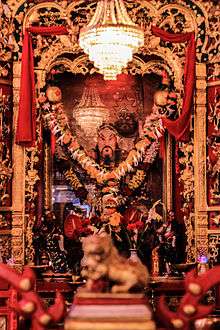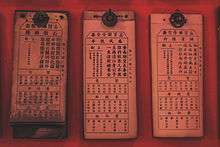Chinatown, Mumbai
Coordinates: 18°57′58″N 72°50′48″E / 18.966012°N 72.846549°E

Up to the 1960s, Mumbai had a small Chinatown in Mazagaon.[1] After the 1962 Sino-Indian War, most Chinese were viewed as traitors, and left the town.[2] Currently, Mumbai has a small ethnic Chinese population of 400 families.[3] The Chinese temple and cemetery are both located at Mazagaon.[3]

The oldest Chinese temple in Mumbai is a shrine dedicated to an army Nobel Kwan Tai Kwon. The shrine is located in a three storey building. It is thronged by devotes and the local Chinese population during the Chinese New Year and Moon festival.[4]
Tucked away behind Dockyard Road Railway Station, Kwan Kung is a small Chinese temple on 12, Nawab Tank Road. It’s not easy to find, nestled between short buildings now used as godowns and residential homes, Mumbai’s only temple is painted red and is a peaceful place that plays meditative chinese music.
Adorned with all the requisite paraphernalia of a typical Chinese temple, including fortune scrolls, paper money and incense sticks, the temple pays homage to the Chinese God of protection, justice and courage Guan Gong. Temple caretaker Albert Tham,[5] whose mother also looked after the temple, is building another temple on the ground floor of the building dedicated to Guan Yin, a female deity revered for mercy, peace and wisdom.
The temple built in winter months (Oct - Dec) 1953, was then in the center of Mumbai’s See Yip Koon community. Originally from Canton in Southern China, the community settled in Mumbai as merchants, traders and sailors. As a result of which buildings adjacent to the temple all have See Yip Koon written on them. While the lane wares a deserted look now, with all its 50-60 Chinese residents gone, it sees a swarm of people only during Chinese New Year. Rotated by the lunar calendar, the Chinese new year generally falls at the end of January or beginning of February.
Like Nawab Tank Road, Mumbai also had another China town located close to what is today Kamathipura. Prior to the 1962 Sino-Indian war, the street boasted a chinese restaurant, traditional chinese medicine store and a grocery store today its bereft of any residents from the middle kingdom. China’s craftsmen, barbers, chefs and cobblers also earlier sent their kids to the Chinese school which was located in Agripada, behind Maratha Mandir Cinema, however naught remains of the school and there is little chance for revival.
The Chinese community in Mumbai has dwindled to a tiny community that continue to share a camaraderie due to a common lineage. While disagreements and greed sometimes engulf them, the community shaken by the atrocities of the 1962 war are now more Indian than Chinese. Many of them are 4th generation Chinese, who although look oriental speak pure Hindi, wear Indian clothes, goto Indian schools and have mostly never visited China.
The Kwan Kung temple is definitely a treasure trove of Chinese spirituality in Mumbai, go seek it and let its warm red glow engulf you.
References
https://commons.wikimedia.org/wiki/Special:Search/Mumbai_chinese_temple
- ↑ http://www.dhapa.com/indian-chinese-in-mumbai/
- ↑ Abidi, S.N.M (2008-02-28). "Say sorry to the Indian Chinese". Khaleej Times.
- 1 2 Someshwar, Savera R (2007-01-23). "Happy Indian Chinese New Year". Rediff.com. Retrieved 2008-10-08.
- ↑ "Search results for "Mumbai chinese temple" - Wikimedia Commons". commons.wikimedia.org. Retrieved 2016-03-06.
- ↑ "Melting pot: Mumbai's Chinese temple glows red for year of the monkey". The Indian Express. 2016-02-08. Retrieved 2016-03-06.